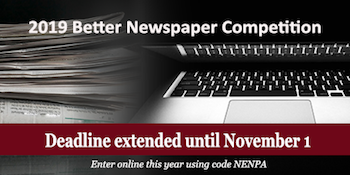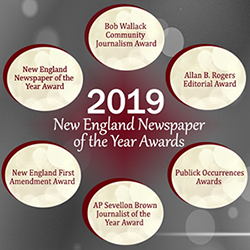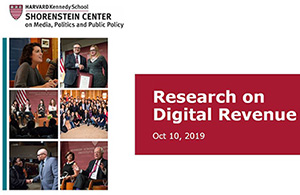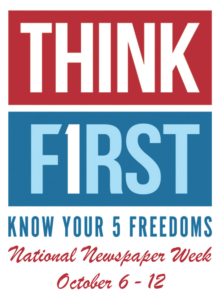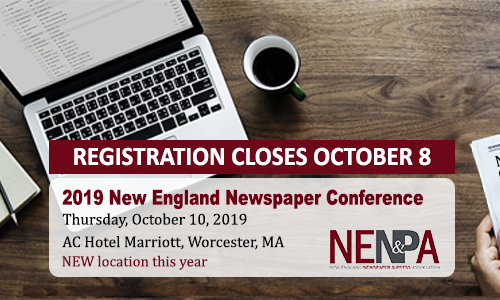Marianne Stanton
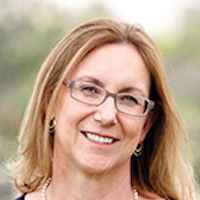

Marianne Stanton is the Editor and Publisher of The Inquirer and Mirror, Nantucket’s weekly newspaper since 1821. She grew up in the newspaper business, starting in the newsroom as a reporter, and is the longest serving publisher in the newspaper’s 198 year history. Under her leadership The Inquirer and Mirror has won numerous awards in journalism, advertising, business development and circulation. She is also a recipient of the Judith Vance Weld Brown Spirit of Journalism Award. Marianne is a Nantucket native, attended the University of Denver and received her MBA from the Simmons Graduate School of Management mid-career.
Registration Closes Oct 8 For The New England Newspaper Conference
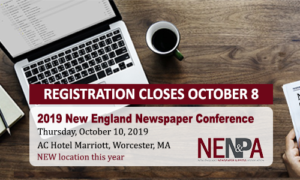
Registration closes for the 2019 New England Newspaper Conference on October 8 at noon.
This year the conference will focus on revenue, alternative funding and future business models for newspapers.
2019 Conference Schedule
- 10:00 a.m.
Registration & Coffee - 11:00 a.m.
Conference Opens With Keynote Speaker Nicco Mele - 12:30 p.m.
Awards Luncheon (please don’t be late!) - 2:30 p.m.
NESNE session – Alternative Funding/Revenue Sources
MNPA Board Meeting - 3:45 p.m.
MNPA session – Creative Approaches to New Revenue
NESNE Board Meeting - 5:00 p.m.
Conference Cocktail Reception (cash bar) - 6:00 p.m.
Yankee Quill Dinner & Awards Presentation
About The Keynote Speaker
Headlining the event this year is Nicco Mele, one of America’s leading forecasters of business, politics, and culture in our fast-moving digital age. He is on the faculty at the Shorenstein Center on Media, Politics, and Public Policy at the Harvard Kennedy School.
Awards Luncheon
During the New England Newspaper Awards Luncheon, the top awards from the region will be announced including the Newspaper of the Year Awards, the prestigious Publick Occurrences Awards, New England First Amendment Award, Allan B. Rogers Editorial Award and the Bob Wallack Community Journalist will also be recognized.
Afternoon Sessions
The New England Society of News Editors will present a panel on Possibilities and Pitfalls of Alternative Funding: Grants, Projects and Ethical Considerations. Seeking and utilizing “alternative funding” for projects has become more common in some newsrooms, and has long been part of the business model for public media. Panelists from The Boston Globe, Connecticut Public Broadcasting, The Ground Truth Project, and The New Hampshire Union Leader, will discuss their experiences and challenges with these revenue streams.
Panelists include:
- Charlie St. Amand, Panel Moderator, Practitioner in Residence, Communication & Journalism Department, Suffolk University
- Charlie Sennott, Founder, The Ground Truth Project / Report for America
- Heidi Flood, Strategic Lead, Partners & Outreach, Boston Globe Media
- Mike Cote, Deputy Managing Editor, Business, New Hampshire Union Leader
- Tim Rasmussen, Chief Content Officer, Connecticut Public Broadcasting Network
Creative Approaches to New Revenue, will be presented by the Massachusetts Newspaper Publishers Association. Faced with decreasing advertising sales, newspapers are getting creative – developing unique ideas to generate new sources of revenue. From special-focus websites and products to ongoing speaker series, these initiatives are reaching new audiences and even bringing in new advertising dollars.
In this program, panelists from several newspapers will describe initiatives they launched and discuss their overall impact on the bottom line.
Panelists Include:
- Marianne Stanton, Panel Moderator, Editor & Publisher, The Inquirer and Mirror
- Jane Seagrave, Publisher, Vineyard Gazette
- George Arwady, Publisher & CEO, The Republican.
- Peter Meyer, Region VP – GateHouse Media, President & Publisher – The Providence Journal, Group Publisher & President – GateHouse New England
Yankee Quill Awards Dinner
Capping the day will be the Yankee Quill Awards, where we will pay tribute to five individuals for their exceptional contributions to their communities and our industry.
Peter Meyer
 Peter Meyer is Regional VP for GateHouse Media, President & Publisher of The Providence Journal and Group Publisher and President of GateHouse New England (GHNE), which includes GateHouse operations in Massachusetts, Rhode Island, Connecticut, New Hampshire and Maine.
Peter Meyer is Regional VP for GateHouse Media, President & Publisher of The Providence Journal and Group Publisher and President of GateHouse New England (GHNE), which includes GateHouse operations in Massachusetts, Rhode Island, Connecticut, New Hampshire and Maine.
GHNE includes 14 daily newspapers, over 100 weeklies, 180 websites, 2 production facilities, as well as a direct mail and commercial printing business. The group is comprised of many notable titles including The Providence Journal, Newport Daily News, Cape Cod Times, Telegram & Gazette, Patriot Ledger, Foster’s Daily Democrat, Standard-Times, MetroWest Daily News, Old Colony Memorial and the Wellesley Townsman. GHNE also partners with ThriveHive, a GateHouse company, to bring dynamic digital marketing solutions to its business customers across the region.
Meyer was named President & Publisher of The Providence Journal in May, Group Publisher and President of GateHouse New England in 2017 and Regional VP of GateHouse Media in 2015. He has a long-time association with the properties he leads across New England, having worked with many of the publications under prior ownership. Peter began his publishing career with Dow Jones & Company, which at the time owned the Cape Cod Times. He served in key leadership roles with the Cape Cod Times, including General Manager and Publisher, and expanded his responsibilities over time with other GateHouse
Media properties in New England.
Meyer earned an MBA from Suffolk University and BS degree from Western Michigan University. He serves as president of the Cape Cod Times Needy Fund, is on the board of the Kelley Foundation, Massachusetts Newspaper Publishers Association and New England Newspaper and Press Association.
He is a past board chairman for Cape & Islands United Way and served as a director for several local non-profit organizations including Cape Cod Conservatory of Music and Art, Cape Cod Community College Foundation, Osterville Rotary Club, Hyannis Area Chamber of Commerce, Cape Cod Symphony Orchestra and the Joshua A. Nickerson Society. Peter is a past recipient of the Hyannis Area Chamber of Commerce Patrick M. Butler Community Service Award.
Meyer and his wife Jeannie live on Cape Cod in Osterville and they have three grown children.
Jane Seagrave
 Jane Seagrave is publisher of the Vineyard Gazette Media Group. In addition to its flagship newspaper, the 173-year-old Vineyard Gazette, the company produces a variety of magazines, websites and newsletters for and about Martha’s Vineyard. Previously, Seagrave was chief revenue officer for The Associated Press in New York. She is a graduate of Bowdoin College and holds a master’s degree from Harvard’s Kennedy School of Government.
Jane Seagrave is publisher of the Vineyard Gazette Media Group. In addition to its flagship newspaper, the 173-year-old Vineyard Gazette, the company produces a variety of magazines, websites and newsletters for and about Martha’s Vineyard. Previously, Seagrave was chief revenue officer for The Associated Press in New York. She is a graduate of Bowdoin College and holds a master’s degree from Harvard’s Kennedy School of Government.
The Radically Rural Conference Opens Today
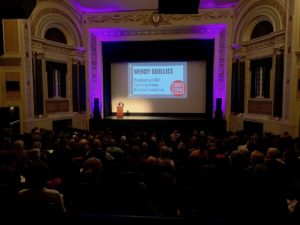
Keene, NH – The annual Radically Rural, two-day summit opened today in Keene, NH. The summit provides a uniquely rural point-of-view for community-building, news coverage, entrepreneurship and economic development.
The Hannah Grimes Center for Entrepreneurship and The Keene Sentinel partner to present Radically Rural, which includes program tracks on entrepreneurship, arts and culture, community journalism, Main Streets and downtowns, working lands and renewable energy.
NENPA Executive Director Linda Conway and NENPA Communications and Events Director Christine Panek are attending the conference and NENPA provided marketing support for the event.
“Rural communities have distinct challenges and opportunities that are not adequately addressed by conventional economic development conferences. Radically Rural prioritizes innovative approaches specifically designed for rural places,” said Terry Williams, President and COO of the Keene Sentinel.
The summit transforms Keene’s downtown into a conference center, utilizing small venues. Attendees will pass coffee houses, restaurants, shops, and meeting places to find event locales at The Colonial Theatre, old County Courthouse, the Historical Society of Cheshire County, Keene State College, Keene Public Library and the Hannah Grimes Center for Entrepreneurship.
The conference continues tomorrow September 20 from 9:00 am – 3:00 pm. For more information visit https://radicallyrural.org.


